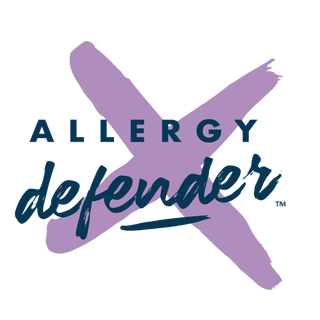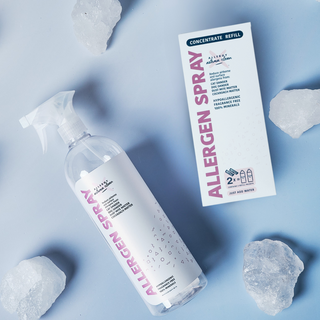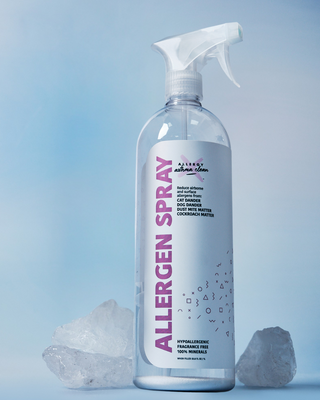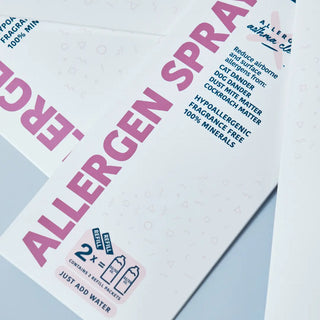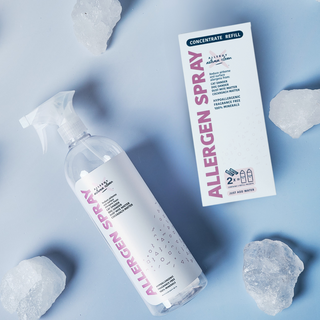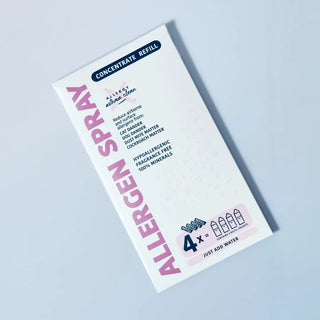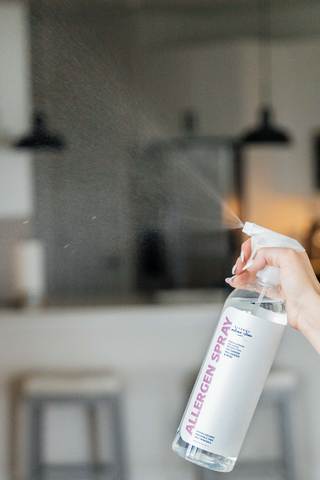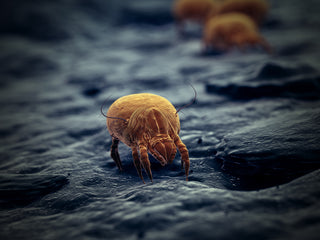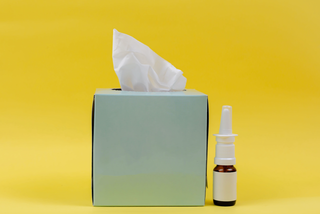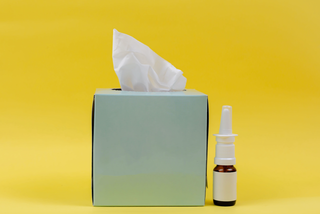Airborne allergens (dust mites, pollen, mold, pet dander, cockroach debris) trigger allergic reactions when inhaled. Your immune system mistakenly produces IgE antibodies that cause mast cells to release histamine, leading to inflammation, sneezing, congestion, itchy eyes, and asthma symptoms. Solutions include regular cleaning with HEPA vacuums, weekly hot water bedding washing, maintaining 30-50% humidity with dehumidifiers, using Allergy Asthma Clean Allergen Spray by Allergy Defender (science-backed for airborne/surface allergen reduction), air purifiers, keeping windows closed during pollen seasons, and addressing mold issues promptly.
Key Takeaways:
- Immune response causes symptoms – IgE antibodies trigger mast cells to release histamine, causing inflammation, sneezing, congestion, itchy watery eyes, and continuous symptoms with ongoing exposure
- Five common airborne allergens – dust mites (bedding/furniture), pollen (trees/grasses/weeds, affects 1 in 5 Americans), mold spores (damp areas), pet dander (skin flakes), cockroach debris
- Regular cleaning essential – vacuum with HEPA filters frequently, wash bedding weekly in hot water, dust with damp cloth, use Allergy Asthma Clean Allergen Spray by Allergy Defender
- Control humidity 30-50% – use hygrometers to monitor levels, employ dehumidifiers/air conditioners to prevent mold and dust mite growth
- Minimize pollen exposure – keep windows closed during high pollen seasons (spring/fall, especially early morning/late afternoon), use air conditioning instead
- Reduce pet allergens – bathe pets regularly, create pet-free bedroom zones, apply Allergy Asthma Clean Allergen Spray by Allergy Defender in air and on bedding
Living with allergies and asthma can be a constant battle, but understanding the root causes and finding effective solutions can make a world of difference. As someone who has personally struggled with both allergies and asthma, I know how challenging it can be.
What Are Airborne Allergens?
Airborne allergens are tiny particles that float in the air and can trigger allergic reactions or asthma attacks when inhaled. These particles come from various sources, including dust mites, pollen, mold, pet dander, and even cockroach debris.
-
Exposure to Allergens: When you breathe in airborne allergens like pollen, dust mites, mold spores, or pet dander, they enter your respiratory system.
-
Immune System Response: For people with allergies, the immune system mistakenly identifies these harmless substances as threats. In response, the immune system produces specific antibodies called Immunoglobulin E (IgE).
-
Release of Histamine and Other Chemicals: The IgE antibodies attach to certain cells called mast cells, which are abundant in the nose, lungs, and skin. Upon re-exposure to the allergen, these mast cells release histamine and other chemicals.
-
Inflammation and Symptoms: Histamine and other chemicals cause the blood vessels in the affected areas (like the nose and eyes) to dilate and become more permeable, leading to inflammation. This results in the common symptoms of an allergic reaction, such as sneezing, itching, runny nose, watery eyes, and congestion.
-
Continued Immune Response: This inflammation can trigger a continuous cycle of symptoms, especially with ongoing exposure to the allergens, making the allergic reaction persistent until the allergen is removed or treated.
Common Allergic Rhinitis Symptoms Include:
Sneezing: Frequent and sudden sneezing is a hallmark of allergic rhinitis.
Nasal Blockage or Constant Sniffles: A perpetually blocked or runny nose is quite normal.
Persistent Itching in Eyes, Nose, or Throat: Continuous itching in these regions can be bothersome, uncomfortable and relentless. Have you ever tried to itch your throat without anyone noticing? Impossible!
Tearful Eyes: Allergens can cause eyes to turn swollen, red, itchy, and watery. Not sure about you but when I itch my eyes it feels so good, but then there's a point when I can't stop. :(
Mucus Drip: Mucus may trickle down the throat, leading to a cough or a sore throat.
Fatigue: These symptoms, particularly nasal congestion, can lead to poor sleep and fatigue.
Allergens That are Easily Airborne
Dust Mites
Dust mites are microscopic creatures that thrive in warm, humid environments. They are commonly found in bedding, upholstered furniture, and carpets. Dust mite allergens can trigger symptoms such as sneezing, runny nose, and itchy eyes, and can inflame asthma symptoms.
Pollen
Pollen is a fine powder produced by plants for reproduction. It's one of the most common airborne allergens, especially during the spring and fall seasons. Pollen from trees, grasses, and weeds can cause hay fever, characterized by sneezing, nasal congestion, and itchy eyes. Hay fever affects 1 in 5 people in the US.
Mold
Mold spores are another common airborne allergen. Mold grows in damp and humid areas, such as bathrooms, basements, and kitchens. Inhaling mold spores can lead to respiratory issues, including coughing, wheezing, and asthma attacks. Be careful with certain molds. Some (such as black mold) can cause major health issues beyond allergy symptoms. If in doubt contact a mold remediating company.
Pet Dander
Pet dander consists of tiny flakes of skin shed by cats, dogs, and other animals. These particles can easily become airborne and trigger allergic reactions. Symptoms may include sneezing, itchy eyes, and a runny nose. Both cat allergens and dog allergens are common culprits.
Cockroach Debris
Cockroach debris, which includes droppings and shed skins, can become airborne and act as allergens. Exposure to these particles can cause allergic reactions and worsen asthma symptoms.
Solutions to Reduce Airborne Allergens
Managing and reducing exposure to airborne allergens is essential for improving quality of life for allergy and asthma sufferers. Here are some practical solutions:
Keep Your Home Clean
Regular cleaning can significantly reduce the presence of allergens in your home. Here are some tips:
- Vacuum frequently: Use a vacuum cleaner with a HEPA filter to capture dust mites, pet dander, and other allergens.
- Wash bedding weekly: Use hot water to kill dust mites.
- Dust with a damp cloth: This helps to trap allergens in the rag, rather than just spreading them around the room.
- Use Allergen Spray: The perfect solution to defend against airborne and surface allergens. Allergen relief that's backed by science for proof it works.
Control Humidity Levels
Maintaining optimal humidity levels in your home can prevent the growth of mold and dust mites. Use a hydrometer to test humidity levels in your home. And once you know the humidity level, then you can use a dehumidifier or air conditioner to achieve a humidity level between 30% and 50%.
Use Air Purifiers
While air purifiers with HEPA filters can work to capture airborne allergens, including pollen, pet dander, and dust mites you need to get the right size and filter for your room, otherwise it won't be effective. You may need to purchase one for every room in your home.
Keep Windows Closed During High Pollen Seasons of Spring and Fall
Pollen levels are typically highest during the early morning and late afternoon. Keeping windows closed during these times can help minimize the amount of pollen that enters your home. Use air conditioning to keep your home cool instead.
Reduce Pet Allergens
If you have pets, there are several steps you can take to reduce pet allergens:
- Bathe pets regularly: This helps to remove dander from their fur.
- Keep pets out of bedrooms: Create a pet-free zone to reduce exposure to allergens while you sleep.
- Use Allergen Spray: It's designed to reduce pet dander and other allergens by spraying it in the air and even on your bedding.- it's that safe.
Address Mold Issues
To prevent mold growth, take the following steps:
- Fix plumbing leaks promptly to prevent moisture buildup.
- Use exhaust fans In bathrooms and kitchens to reduce humidity.
- Clean moldy areas with a mixture of water and bleach.
Professional Solutions
In some cases, professional intervention may be necessary. Consider hiring:
- A professional cleaning service to help thoroughly remove allergens from your home
- A carpeting cleaning company
- An HVAC team to clean your air ducts
Living with allergies and asthma can be challenging, but understanding the causes and implementing practical solutions can make a significant difference. Keep your home clean, control humidity levels, use air purifiers, and take steps to reduce exposure to specific allergens, to help you create a healthier living environment.
By taking proactive steps, you can reduce the occurrence of allergy and asthma attacks and breathe easier. Amen!
